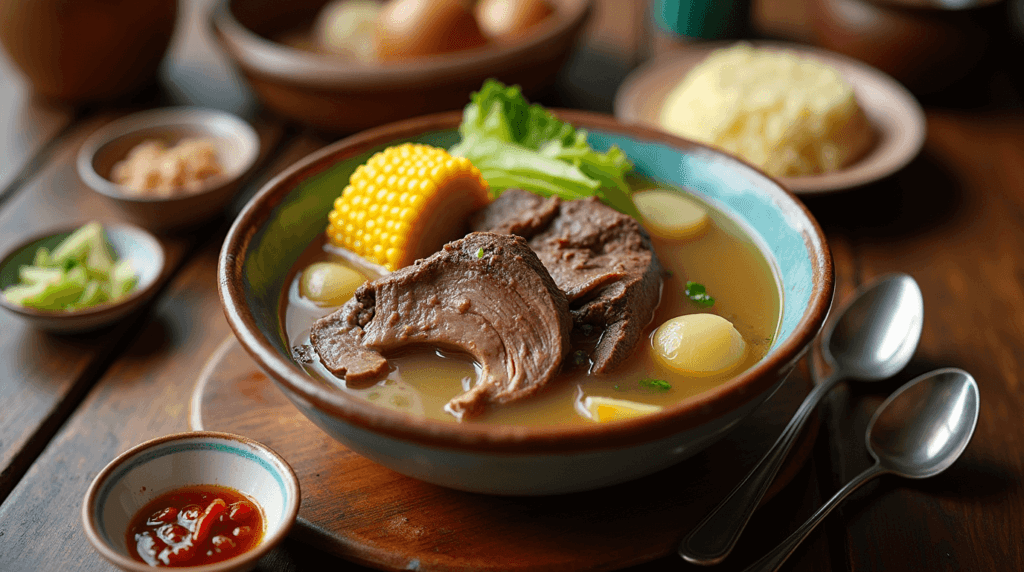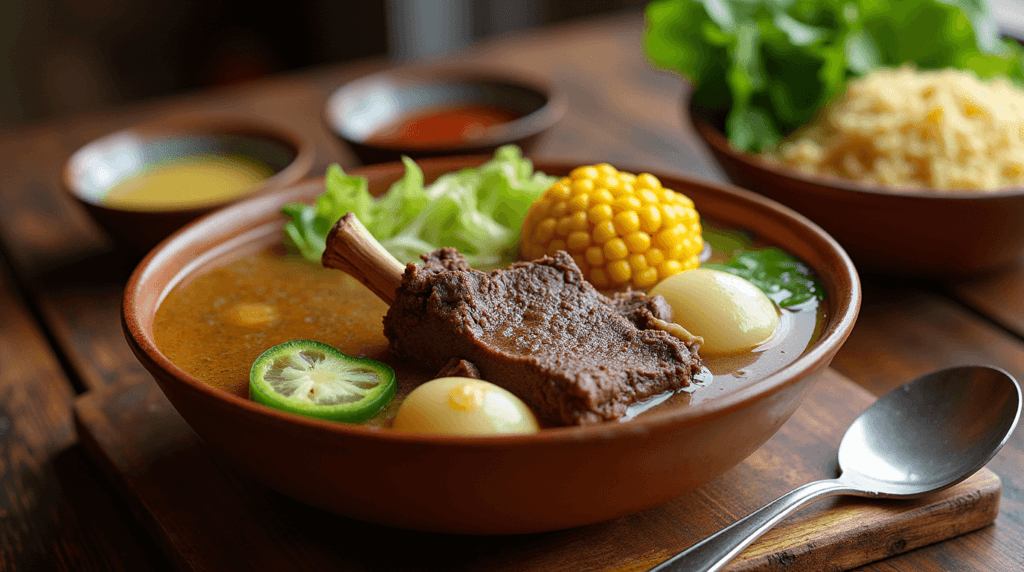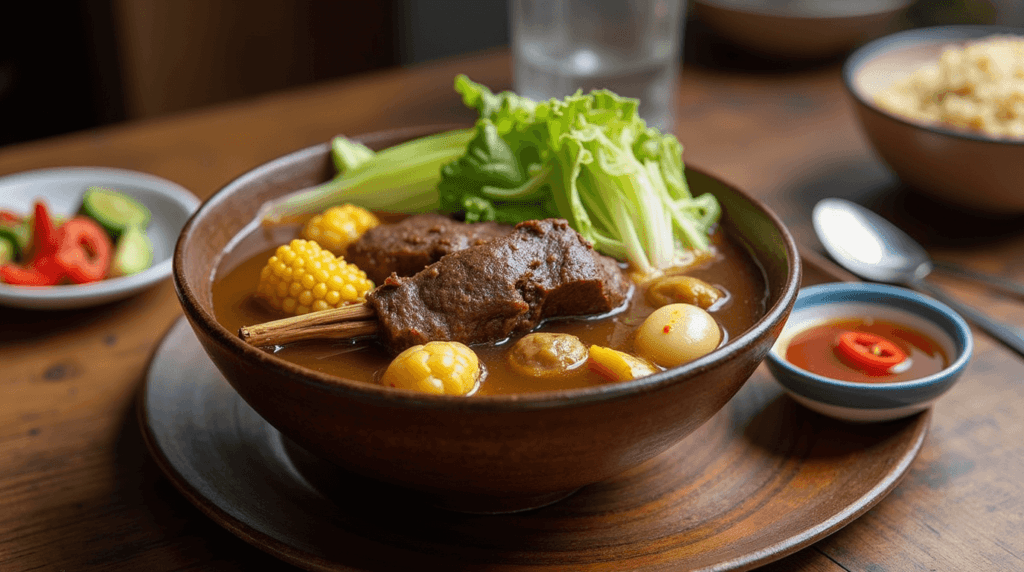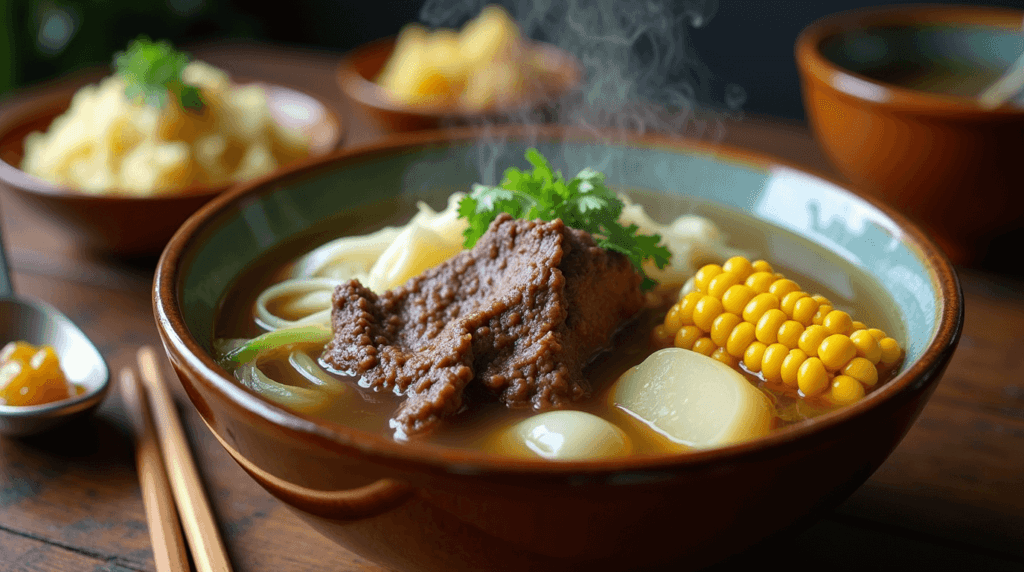If there’s one dish that warms both the stomach and the heart in Filipino households, it’s Beef Bulalo. This rich and flavorful soup is made by slow-cooking beef shanks and bone marrow until the meat becomes fall-off-the-bone tender and the broth turns deeply savory. Served steaming hot with vegetables like corn on the cob, cabbage, and potatoes, Bulalo is more than just food — it’s a comforting experience.
In the Philippines, Bulalo has long been a beloved staple, especially in cooler regions like Tagaytay and Batangas, where it’s often enjoyed with a scenic view and a side of garlic rice. Whether found at a humble roadside carinderia or a high-end Filipino restaurant, Bulalo continues to draw crowds with its nostalgic flavors and hearty appeal.
But what makes Beef Bulalo so special in 2025? In a time when food trends are constantly evolving, people still crave traditional dishes that connect them to their roots. Bulalo offers that exact comfort — a taste of home, family gatherings, and Sunday lunches. Thanks to modern cooking methods and a renewed love for authentic Filipino cuisine, Bulalo has not only survived but thrived, proving it’s more than just a classic — it’s a timeless favorite.
Table of Contents :

¶ What is Beef Bulalo?
Beef Bulalo is one of the most beloved and iconic Filipino soups, known for its rich, meaty broth, tender beef shank, and melt-in-your-mouth bone marrow. This dish is traditionally slow-cooked for hours, allowing the flavors to fully develop and the beef to become incredibly tender. Served hot, often with vegetables like corn, cabbage, and potatoes, Bulalo is a perfect example of Filipino comfort food at its best.
✅ What Makes Bulalo Special?
One of the key reasons why Bulalo stands out from other beef soups is its use of beef shank and bone marrow. The slow simmering process extracts the collagen and fat from the bones, creating a deep, umami-rich broth that is both nourishing and flavorful.
- Beef Shank (or “bulalo” in Tagalog) – This cut of beef contains tough muscle and connective tissues that break down during slow cooking, resulting in fork-tender meat.
- Bone Marrow – The most prized part of Bulalo, bone marrow melts into the broth, giving it a silky, buttery texture and an incredibly rich taste.
- Clear but Flavorful Broth – Unlike other stews or thick soups, Bulalo has a light yet intensely beefy broth, thanks to long, slow simmering.
Bulalo is best enjoyed piping hot, with a side of white rice, fish sauce with calamansi, and chili peppers for extra flavor.
✅ A Traditional Filipino Comfort Food
Bulalo is more than just a dish; it’s a symbol of warmth, hospitality, and Filipino tradition. It has been a part of Filipino cuisine for generations, enjoyed in family gatherings, fiestas, and roadside eateries.
- Historical Roots – Bulalo is believed to have originated in the Southern Luzon region, where cattle farming is common. The abundance of beef shanks made this dish popular among locals.
- A Dish for Every Occasion – Whether it’s a cold, rainy day or a celebratory feast, Bulalo is a go-to meal that brings people together.
- Cooked with Patience and Love – Traditional Bulalo recipes require hours of slow cooking, which reflects the Filipino approach to food—prepared with care, meant to be shared.
Even today, Bulalo remains a must-try dish for tourists and a favorite comfort food for Filipinos worldwide.
✅ Regional Variations of Bulalo
While the basic elements of Bulalo remain the same, there are some regional differences that make it even more exciting.
- Tagaytay Bulalo – Perhaps the most famous version, often served in restaurants overlooking the scenic Taal Volcano. Tagaytay’s cool climate makes Bulalo the perfect warm dish to enjoy. It is known for its clear and pure broth, with minimal seasoning to highlight the natural beef flavor.
- Batangas Bulalo – This variation is richer and more intensely flavored. Unlike Tagaytay’s clean and simple broth, Batangas Bulalo is typically darker and more heavily seasoned, often incorporating soy sauce, black pepper, and garlic. Some versions are even spicier.
No matter the variation, Bulalo remains a must-try dish that embodies the heart of Filipino cuisine.
✅ Common Ingredients in Beef Bulalo :
To make a traditional Bulalo, you’ll need a few key ingredients, all of which contribute to its rich taste and hearty texture:
- Beef Shank – The star of the dish, providing tender meat and deep beef flavor.
- Bone Marrow – Gives the broth its distinct richness and smooth mouthfeel.
- Water – Used as the base to create the flavorful broth.
- Onion & Garlic – Enhance the depth of flavor in the soup.
- Peppercorns & Salt – Basic seasonings that highlight the natural taste of the beef.
- Corn on the Cob – Adds a subtle sweetness to balance the broth.
- Cabbage – A staple vegetable in Bulalo, giving it a light and fresh contrast.
- Potatoes – Provide an additional layer of texture and absorb the delicious broth.
- Fish Sauce (Optional) – Often added to enhance the umami taste of the soup.
With these simple yet flavorful ingredients, Bulalo is both easy to prepare and deeply satisfying, making it a favorite among Filipinos and food lovers alike.
¶ Why is Beef Bulalo Still Popular in 2025?

Despite the rise of food trends like plant-based diets, fusion cuisine, and convenience meals, Beef Bulalo continues to hold its place as one of the Philippines’ most cherished dishes. In 2025, its popularity hasn’t waned — in fact, it’s thriving, thanks to its deep cultural roots, satisfying flavors, and its ability to evolve with the times.
✅ Comfort Food in Changing Times
In a fast-paced world filled with uncertainty, people are returning to comfort food — meals that remind them of home, warmth, and simpler days. Bulalo fits this need perfectly.
- It’s a dish that evokes nostalgia, reminding many Filipinos of family lunches on Sundays, rainy days huddled around a hot bowl of soup, or road trips to Tagaytay.
- The hearty broth, tender meat, and wholesome vegetables offer a sense of fullness and comfort that goes beyond taste.
- As people seek deeper emotional connections through food, Bulalo remains a reliable go-to — especially in colder months or as a soothing meal after a long day.
In short, Bulalo’s power lies not just in flavor, but in the memories and emotions it stirs.
✅ Health Benefits of Bulalo
While Bulalo is known for its richness, it also offers nutritional benefits — especially when enjoyed in moderation.
- Bone marrow and collagen from the beef shank are packed with nutrients that support joint health, skin elasticity, and immune function.
- The long cooking process extracts beneficial minerals from the bones, creating a broth that’s not only flavorful but also nourishing.
- Vegetables like cabbage, corn, and potatoes add fiber, vitamins, and antioxidants to balance the dish.
- Many health-conscious cooks in 2025 are modifying Bulalo to make it lower in sodium or fat, proving that even traditional dishes can be tweaked for modern wellness goals.
When eaten as part of a balanced diet, Bulalo is a comforting and nutrient-rich meal that satisfies both the heart and body.
✅ Availability in Restaurants & Home Cooking
One reason for Bulalo’s lasting popularity is its widespread availability — whether you’re dining out or cooking at home.
- Tagaytay and Batangas remain the most iconic destinations to enjoy Bulalo. Restaurants there often serve it in hot clay pots or metal cauldrons, with scenic views of the Taal Volcano as a backdrop.
- In 2025, more Filipino restaurants worldwide are also adding Bulalo to their menus, catering to the growing international love for Filipino cuisine.
- At home, many families continue to prepare Bulalo as a weekend treat. Its ingredients are affordable and accessible, making it an easy choice for everyday meals or special gatherings.
Whether you’re at a roadside eatery or a high-end bistro, Bulalo is everywhere — and for good reason.
✅ Adaptability of the Bulalo Recipe
While traditionally slow-cooked over an open flame for hours, modern technology has made preparing Bulalo more convenient than ever.
- Instant Pots, pressure cookers, and slow cookers allow home cooks to achieve the same rich flavor and tenderness in a fraction of the time.
- Health-conscious cooks can easily adjust the recipe — using leaner cuts of beef, reducing fat, or adding more vegetables — without sacrificing taste.
- Creative twists on the dish are also emerging, like Bulalo ramen, Bulalo paella, or Bulalo with miso-infused broth, reflecting the global fusion trend.
Its versatility and ability to evolve with time have helped Bulalo remain not only relevant, but exciting for a new generation of food lovers.
¶ How to Enjoy Beef Bulalo at Its Best

Beef Bulalo is best enjoyed when it’s cooked to perfection and served the right way. Whether you’re making it at home or seeking out the best spots in the Philippines, knowing how to prepare, pair, and enhance its flavors can take your Bulalo experience to the next level. Here’s everything you need to know.How to Cook Bulalo at Home
Cooking Bulalo from scratch may seem intimidating, but it’s actually a simple and rewarding process. The key lies in patience—slow-cooking the beef shank and bone marrow extracts the deep flavors that make this dish truly special.
🔹Basic Steps to Make Homemade Bulalo:
- Prepare the Ingredients – You’ll need beef shank, bone marrow, water, onion, garlic, peppercorns, and salt as the base ingredients. Optional vegetables include corn, cabbage, potatoes, and green onions.
- Boil and Simmer – In a large pot, cover the beef shank and bone marrow with water. Bring to a boil and remove any scum or impurities that rise to the surface.
- Slow Cook for Flavor – Lower the heat and let the broth simmer for at least 2-3 hours (or until the meat is fork-tender). If using a pressure cooker or Instant Pot, cooking time can be reduced to 45-60 minutes.
- Add Vegetables – Once the meat is tender, add corn on the cob, potatoes, and cabbage. Cook for another 10-15 minutes until the vegetables are soft but not mushy.
- Season to Perfection – Add salt and pepper to taste. Some prefer a bit of fish sauce (patis) for extra umami.
- Serve Hot – Ladle into bowls, ensuring each serving gets a good mix of broth, beef, bone marrow, and vegetables.
✅ Best Places to Eat Bulalo in the Philippines
If you want the best Bulalo experience, there’s no better place than the Philippines itself! Some of the most famous Bulalo spots can be found in Tagaytay and Batangas, where the cool climate makes this hot soup even more enjoyable.
🔹Famous Bulalo Restaurants to Try:
🍲 Tagaytay:
- Mahogany Market Bulalohan – A must-visit for authentic, no-frills Bulalo that locals love.
- Leslie’s Tagaytay – Famous for its steaming Bulalo served with a scenic view of Taal Volcano.
- Balay Dako – A more upscale experience, offering a well-balanced, perfectly seasoned Bulalo.
🍲 Batangas:
- Jaytee’s Classic Bulalo – Known for its deep, flavorful broth and tender beef.
- Rose & Grace Restaurant – A long-time favorite with generous servings.
- Bulalo Point – Offers spicy Bulalo, a twist for those who love bold flavors.
Beyond these locations, Bulalo is available in many local eateries, food parks, and carinderias across the Philippines. Whether in a humble roadside stall or a fancy restaurant, it remains a dish that Filipinos and tourists alike crave.
✅ Perfect Side Dishes and Pairings
A great bowl of Bulalo is made even better with the right side dishes and condiments. These accompaniments help enhance the flavor and overall experience of enjoying Bulalo:
🥢 Garlic Rice – The rich broth of Bulalo pairs beautifully with the aromatic crunch of garlic rice. This combination makes the meal even more satisfying.
🥢 Fish Sauce with Calamansi & Chili (Sawsawan) – A small bowl of patis (fish sauce) mixed with calamansi juice and chopped chili peppers adds a savory, citrusy kick that enhances the beef flavor.
🥬 Steamed Vegetables – Bulalo is already rich, so a side of steamed pechay (bok choy), kangkong (water spinach), or other greens balances the meal with freshness.
🫓 Crispy Tawilis (Fried Fish) – A regional specialty in Tagaytay, fried tawilis (small freshwater fish) is often served alongside Bulalo for textural contrast.
🥢 Hot Kapeng Barako (Batangas Coffee) – If you’re dining in Batangas, finishing your meal with a strong cup of Kapeng Barako (Batangas-grown coffee) is the perfect way to complete the experience.
With these perfect pairings, every bite of Bulalo becomes more flavorful and memorable.
✅ Pro Tips for a Rich, Flavorful Broth

The heart of a great Bulalo lies in its broth. Here are some expert tips to make it as rich and flavorful as possible:
Slow Cooking is Key – The longer you simmer the beef shank and bones, the better the flavor. A good Bulalo should be cooked for at least 2-3 hours (or longer for even deeper taste).
Skim the Fat and Impurities – To achieve a clear and clean-tasting broth, regularly skim off excess fat and foam that rises to the surface while boiling.
Season Gradually – Instead of adding all the salt at once, season the broth in stages to build a more balanced flavor.
Use Fresh Ingredients – The quality of beef, marrow bones, and vegetables makes a huge difference in taste. Opt for fresh, high-quality beef shank and organic vegetables for the best results.
Add a Beef Bouillon Cube or Fish Sauce – While traditional Bulalo relies solely on natural beef flavors, some cooks add a beef bouillon cube or a splash of fish sauce to enhance umami.
Serve Immediately – Bulalo is best enjoyed fresh off the stove, when the broth is still hot and the marrow is perfectly melt-in-your-mouth soft.
✅ Final Thoughts
Whether you’re cooking it at home or enjoying it in a famous Filipino restaurant, Bulalo remains one of the best and most comforting dishes you can have. With its rich broth, tender meat, and fresh vegetables, it’s no surprise that people continue to love this dish in 2025.
So, have you tried authentic Beef Bulalo before? What’s your favorite way to enjoy it? Share your thoughts in the comments below!
¶ Conclusion
Beef Bulalo isn’t just a meal — it’s a culinary experience steeped in Filipino tradition and comfort. From its humble origins to its continued popularity in 2025, Bulalo remains a beloved dish for good reason. Its rich, savory broth, tender beef shank, and soul-warming marrow create a combination that speaks to the heart as much as it satisfies the stomach.
In a world where food trends come and go, Bulalo’s enduring appeal lies in its simplicity, flavor, and emotional connection. Whether it’s enjoyed in a Tagaytay restaurant overlooking the mountains or lovingly prepared in a home kitchen using modern appliances, Bulalo brings people together — offering nourishment, nostalgia, and joy in every bowl.
So if you haven’t yet tried this iconic Filipino comfort food, now’s the perfect time. Gather your ingredients, fire up your stove (or Instant Pot), and prepare to fall in love with a dish that has stood the test of time.
Or better yet, if you’re planning a visit to the Philippines, make sure a steaming bowl of authentic Bulalo is on your food bucket list — especially in Tagaytay or Batangas, where it’s served with tradition and pride.
Have you tried Beef Bulalo?
💬 We’d love to hear from you!
👉 Share your experience in the comments below — whether it’s your go-to recipe, your favorite Bulalo spot, or your first taste of this heartwarming dish.
Don’t forget to share this post with your foodie friends who love comfort food and cultural eats!
*** GistRecipes ***
Reviews:
There are no reviews yet. Be the first one to write one.

